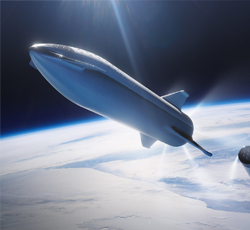
SpaceX’s 3rd Starship launch makes it to space without exploding, but breaks up on reentry
- by Orlando Sentinel
- Mar 14, 2024
- 0 Comments
- 0 Likes Flag 0 Of 5

— SpaceX (@SpaceX) March 14, 2024
NASA also is eagerly awaiting Starship to come to fruition so it can support the Artemis III mission as the lander that will bring humans, including the first woman, back to the moon’s surface for the first time since Apollo 17 in 1972. That mission could come as soon as September 2026.
“Congrats to @SpaceX on a successful test flight! Starship has soared into the heavens,” posted NASA Administrator Bill Nelson on X. “Together, we are making great strides through Artemis to return humanity to the moon — then look onward to Mars.”
To get there, though, more SpaceX test flights must continue from Texas, with as many as six more planned for 2024, according to SpaceX CEO Elon Musk. The third one was a step forward in its efforts.
The Super Heavy booster’s 33 Raptor engines that produce more than 17 million pounds of thrust on liftoff performed just as well as the last flight. They remained lit until SpaceX performed a hot staging maneuver during which all but three of the Raptor engines shut down while letting the Starship upper stage light its engines and safely separate.
The Starship then continued its climb into space for a suborbital trip that took it east for an attempt to splash down in the Indian Ocean.
The second launch attempt in November saw both the Super Heavy booster explode on its way back down to the Gulf of Mexico and Starship self-destruct before it completed its ascent burn.
The Starship and Super Heavy stages are seen during broadcast of Orbital Flight Test 3 that launched from SpaceX’s Starship facility in Boca Chica, Texas on March 14, 2024. The Super Heavy booster remained intact on its way back to Earth at left while the Starship upper stage continued its ascent burn in space. (Courtesy/SpaceX)
This time, though, the Super Heavy booster made it back to Earth, although not completing what SpaceX had planned, a controlled burn right above the surface of the Gulf to demonstrate a capability similar to how Falcon 9 first-stage boosters land. SpaceX lost control of the booster still traveling at more than 600 mph when it hit the water.
The Starship upper stage completed its burn less than 10 minutes after launch and began a 30-minute coasting phase during which SpaceX performed some new tests including the opening and closing of the spacecraft’s payload door and a fuel transfer demonstration on board the spacecraft.
The Starship upper stage begins reentry into Earth's atmosphere during Orbital Flight Test 3 that launched from
Boca Chica, Texas on March 14, 2024. (Courtesy/SpaceX)
Images of reentry delivered via a Starlink satellite flying on board that connected to SpaceX’s constellation showed plasma buildup surrounding the spacecraft just under 62 miles altitude with cheers from SpaceX employees coming in waves in the background during the broadcast. Imagery cut out with Starship still traveling at 16,500 mph at about 46 miles altitude.
“This was wild. We’ve never seen the super hot plasma grow in real-time,” Musk posted to X.
Watch the super hot plasma field grow as Starship re-enters the atmosphere! pic.twitter.com/to4UOF2Kpd
Please first to comment
Related Post
Stay Connected
Tweets by elonmuskTo get the latest tweets please make sure you are logged in on X on this browser.






 Energy
Energy
















